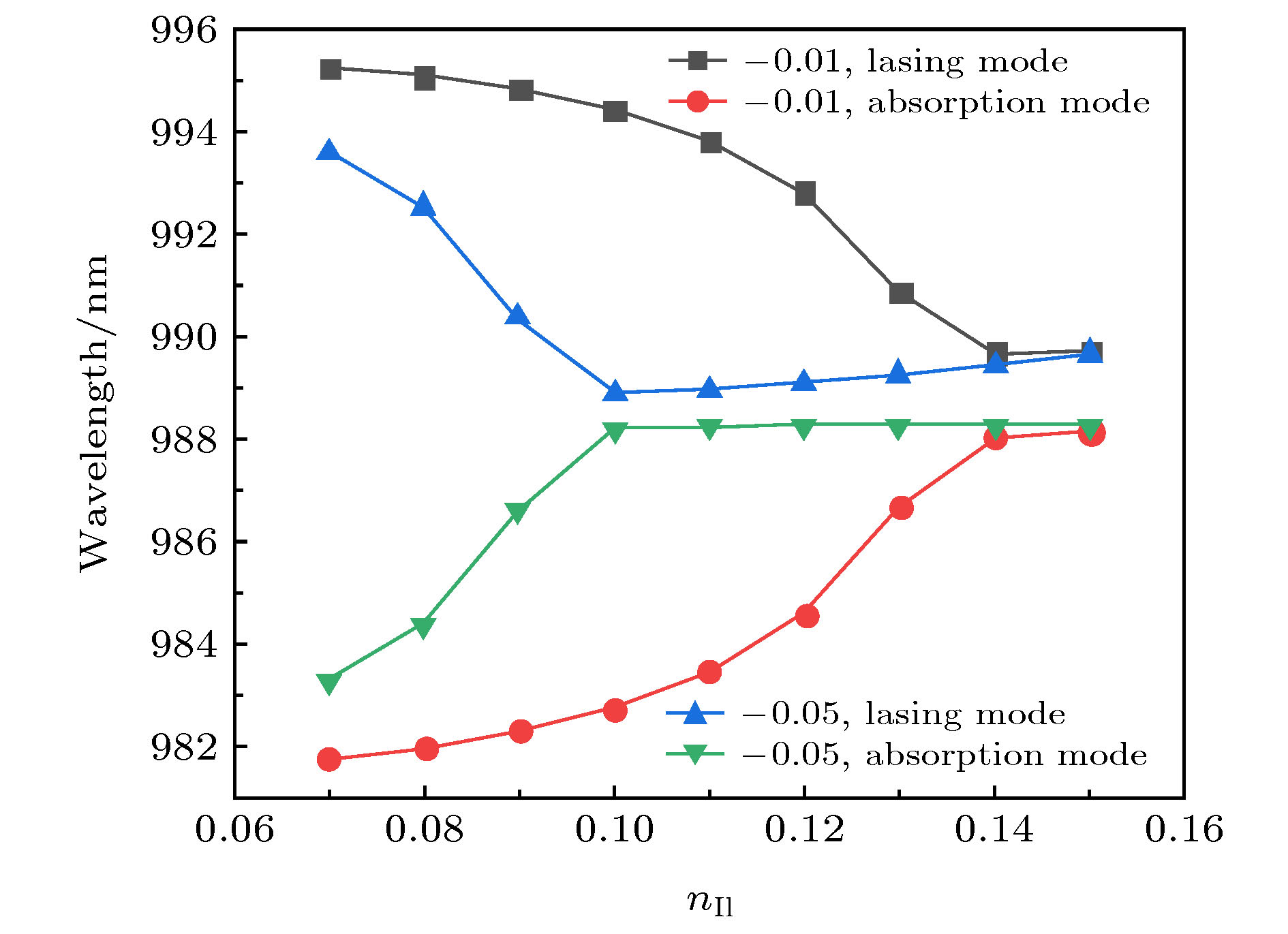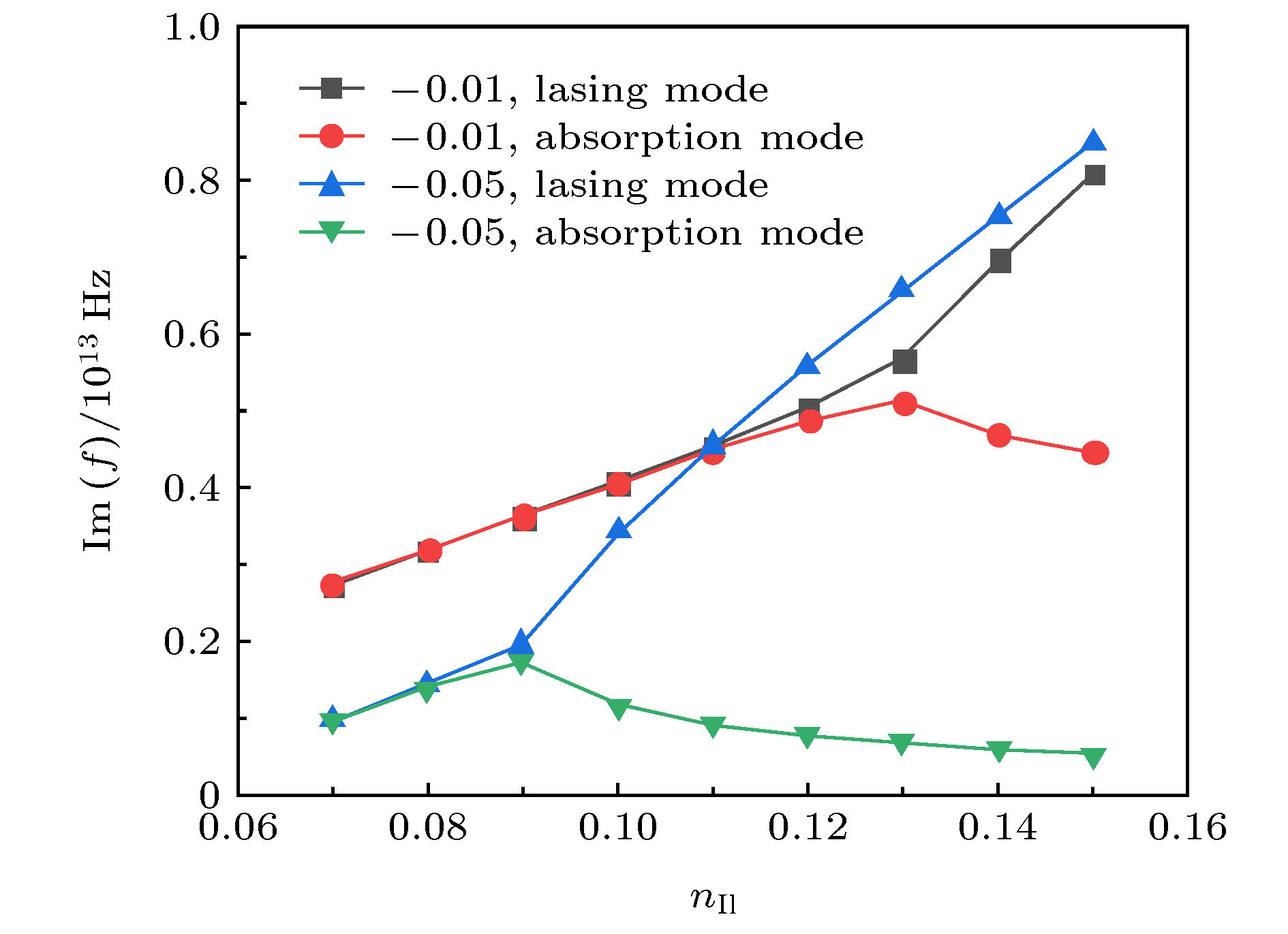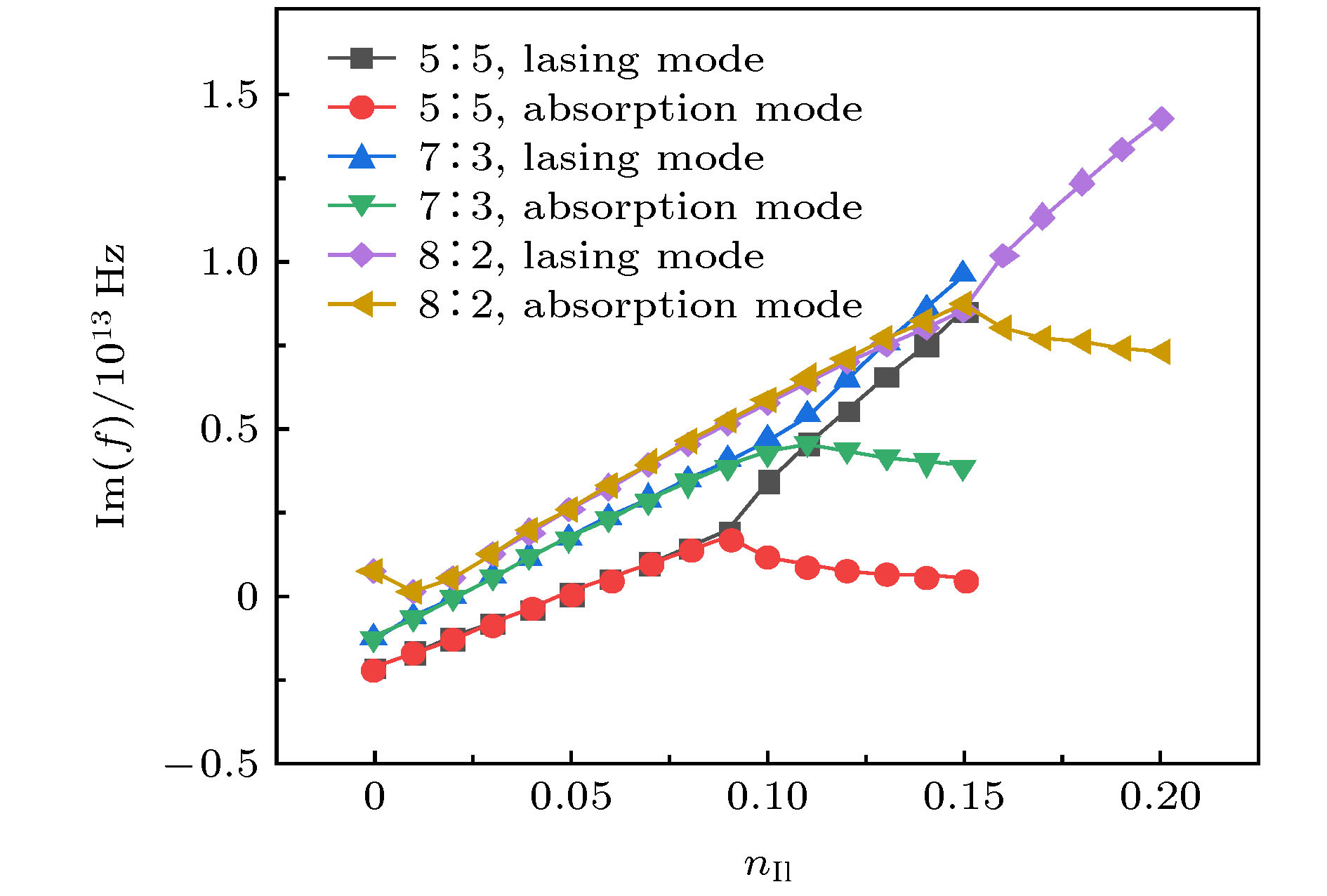-
非厄米的描述对于开放系统有重要意义, 满足parity-time对称性的哈密顿量, 其参数在一定范围内可以使能量具有实的本征值. 本文通过模拟, 研究了损耗大小以及结构对称性对条形波导中的parity-time对称性的影响, 并通过实验发现了电注入条件下由parity-time对称破缺导致的脊条波导模式间隔加倍、模式数减半的现象.
-
关键词:
- parity-time对称性 /
- 电注入 /
- 半导体激光器 /
- 模式控制
The non-Hermitian description is of great significance for open systems, and the Hamiltonian which satisfies parity-time symmetry can make the energy have real eigenvalue within a certain range. The properties of parity-time symmetry have bright application prospects in optical systems. For semiconductor lasers, the parity-time symmetry can be constructed by adjusting the level of electrical injection to help achieve better mode control. Electric injection is easier to realize than optical pump when the device size is small and the structure is complex. Therefore, we hope to analyze the characteristics of the laser that satisfies the parity-time symmetry condition under the condition of electric injection. In this paper, we simulate the effects of different set loss values on parity-time symmetry. It is found that with the increase of set loss value, the imaginary part of the refractive index of the gain cavity corresponding to the parity-time symmetry breaking point so-called exceptional point will decrease, and the imaginary part of the characteristic frequency corresponding to the exceptional point will also decrease. We also simulate the effect of structural size ratio of gain region and loss region on parity-time symmetry. On condition that the total cavity length and the imaginary part of the refractive index of the loss region remain unchanged, as the gain cavity becomes longer and the loss cavity becomes shorter, the imaginary part of the refractive index of the gain cavity corresponding to the exceptional point will increase, and the imaginary part of the characteristic frequency corresponding to the exceptional point will also increase. And we qualitatively explain the above phenomenon through the coupled mode equations. Through experiments, metal organic chemical vapor deposition (MOCVD) and standard lithography techniques are used to fabricate asymmetric ridge lasers. Under thermoelectric cooler (TEC) refrigeration and by controlling the injection level of the gain area, the doubled mode spacing and halved mode number of ridge waveguide are found for the first time due to the parity-time symmetry breaking under the condition of electric injection. We believe that the study of parity-time symmetry in ridge laser under the condition of electric injection will be of great help in implementing the mode control.-
Keywords:
- parity-time symmetry /
- electric injection /
- semiconductor laser /
- mode control
[1] Gamow G 1928 Z. Für Phys. 51 204
 Google Scholar
Google Scholar
[2] Dirac P A M, F R S 1942 Proceedings A 180 1
[3] Feshbach H, Weisskopf V F, Porter C E 1954 Nucl React 96 227
[4] Brower R C, Furman M A, Moshe M 1978 Phys. Lett. B 76 213
 Google Scholar
Google Scholar
[5] Denham S A, Harms B C, Jones S T 1981 Nucl. Phys. B 188 155
 Google Scholar
Google Scholar
[6] Andrianov A A 1982 Ann. Phys.-New York 140 82
 Google Scholar
Google Scholar
[7] Hollowood T J 1992 Nucl. Phys. B 384 523
 Google Scholar
Google Scholar
[8] Scholtz F G, Geyer H B, Hahne F J W 1992 Ann. Phys.-New York 213 74
 Google Scholar
Google Scholar
[9] Caliceti E, Graffi S, Maioli M 1980 Commun. Math. Phys. 75 51
 Google Scholar
Google Scholar
[10] Bender C M, Boettcher S 1998 Phys. Rev. Lett. 80 5243
 Google Scholar
Google Scholar
[11] Bender C M, Dunne G V, Meisinger P N 1998 Phys. Lett. A 252 272
[12] Dorey P, Dunning C, Roberto T 2001 J. Phys. A: Gen. Phys. 34 L391
 Google Scholar
Google Scholar
[13] Ruschhaupt A, Delgado F, Muga J G 2017 J. Phys. A: Gen. Phys. 38 L171
[14] Brandstetter M, Liertzer M, Deutsch C, Klang P, Schöberl J, Türeci H E, Strasser G, Unterrainer K, Rotter S 2014 Nat. Commun. 5 4034
 Google Scholar
Google Scholar
[15] Gao Z, Fryslie S T M, Thompson B J, Carney P S, Choquette K D 2017 Optica 4 323
 Google Scholar
Google Scholar
[16] Guo A, Salamo G J, Duchesne D, Morandotti R, Volatierravat M, Aimez V, Siviloglou G A, Christodoulides D N 2009 Phys. Rev. Lett. 103 093902
 Google Scholar
Google Scholar
[17] Makris K G, El-Ganainy R, Christodoulides D N, Musslimani Z H 2008 Phys. Rev. Lett. 100 103904
 Google Scholar
Google Scholar
[18] Zhen B, Hsu C W, Igarashi Y, Lu L, Kaminer I, Pick A, Chua S L, Joannopoulos J D, Marin S 2015 Nature 525 354
 Google Scholar
Google Scholar
[19] Doppler J, Mailybaev A A, Böhm J, Kuhl U, Girschik A, Libisch F, Milburn T J, Rabl P, Moiseyev N, Rotter S 2016 Nature 537 76
 Google Scholar
Google Scholar
[20] Xu H, Mason D, Jiang L, Harris J G E 2016 Nature 537 80
 Google Scholar
Google Scholar
[21] Gu Z, Zhang N, Lyu Q, Li M, Xiao S, Song Q 2016 Laser Photonics Rev. 10 588
 Google Scholar
Google Scholar
[22] Zhang N, Gu Z, Wang K, Li M, Ge L, Xiao S, Song Q 2017 Laser Photonics Rev. 11 1700052
 Google Scholar
Google Scholar
[23] Zhao S, Qi A, Wang M, Qu H, Lin Y, Dong F, Zheng W 2018 Opt. Express 26 3518
 Google Scholar
Google Scholar
[24] Coldren L A 2012 Diode Lasers and Photonic Integrated Circuits (America: John Wiley & Sons) pp335–391
[25] Rüter C E, Makris K G, El-Ganainy R, Christodoulides D N, Segev M, Kip D 2010 Nat. Phys. 6 192
 Google Scholar
Google Scholar
[26] Hodaei H, Hassan A U, Wittek S, Garcia-Gracia H, El-Ganainy R, Christodoulides D N, Khajavikhan M 2017 Nature 548 187
 Google Scholar
Google Scholar
-
图 9 腔模强度与波长关系 (a)注入电流为100 mA; (b)注入电流分别为310 mA(黑线)、320 mA(红线)以及330 mA(蓝线)
Fig. 9. Relationship between the normalized intensity and wavelength of cavity modes: (a) The injection current is 100 mA; (b) the injection current is 310 mA (black line), 320 mA (red line) and 330 mA (blue line), respectively.
-
[1] Gamow G 1928 Z. Für Phys. 51 204
 Google Scholar
Google Scholar
[2] Dirac P A M, F R S 1942 Proceedings A 180 1
[3] Feshbach H, Weisskopf V F, Porter C E 1954 Nucl React 96 227
[4] Brower R C, Furman M A, Moshe M 1978 Phys. Lett. B 76 213
 Google Scholar
Google Scholar
[5] Denham S A, Harms B C, Jones S T 1981 Nucl. Phys. B 188 155
 Google Scholar
Google Scholar
[6] Andrianov A A 1982 Ann. Phys.-New York 140 82
 Google Scholar
Google Scholar
[7] Hollowood T J 1992 Nucl. Phys. B 384 523
 Google Scholar
Google Scholar
[8] Scholtz F G, Geyer H B, Hahne F J W 1992 Ann. Phys.-New York 213 74
 Google Scholar
Google Scholar
[9] Caliceti E, Graffi S, Maioli M 1980 Commun. Math. Phys. 75 51
 Google Scholar
Google Scholar
[10] Bender C M, Boettcher S 1998 Phys. Rev. Lett. 80 5243
 Google Scholar
Google Scholar
[11] Bender C M, Dunne G V, Meisinger P N 1998 Phys. Lett. A 252 272
[12] Dorey P, Dunning C, Roberto T 2001 J. Phys. A: Gen. Phys. 34 L391
 Google Scholar
Google Scholar
[13] Ruschhaupt A, Delgado F, Muga J G 2017 J. Phys. A: Gen. Phys. 38 L171
[14] Brandstetter M, Liertzer M, Deutsch C, Klang P, Schöberl J, Türeci H E, Strasser G, Unterrainer K, Rotter S 2014 Nat. Commun. 5 4034
 Google Scholar
Google Scholar
[15] Gao Z, Fryslie S T M, Thompson B J, Carney P S, Choquette K D 2017 Optica 4 323
 Google Scholar
Google Scholar
[16] Guo A, Salamo G J, Duchesne D, Morandotti R, Volatierravat M, Aimez V, Siviloglou G A, Christodoulides D N 2009 Phys. Rev. Lett. 103 093902
 Google Scholar
Google Scholar
[17] Makris K G, El-Ganainy R, Christodoulides D N, Musslimani Z H 2008 Phys. Rev. Lett. 100 103904
 Google Scholar
Google Scholar
[18] Zhen B, Hsu C W, Igarashi Y, Lu L, Kaminer I, Pick A, Chua S L, Joannopoulos J D, Marin S 2015 Nature 525 354
 Google Scholar
Google Scholar
[19] Doppler J, Mailybaev A A, Böhm J, Kuhl U, Girschik A, Libisch F, Milburn T J, Rabl P, Moiseyev N, Rotter S 2016 Nature 537 76
 Google Scholar
Google Scholar
[20] Xu H, Mason D, Jiang L, Harris J G E 2016 Nature 537 80
 Google Scholar
Google Scholar
[21] Gu Z, Zhang N, Lyu Q, Li M, Xiao S, Song Q 2016 Laser Photonics Rev. 10 588
 Google Scholar
Google Scholar
[22] Zhang N, Gu Z, Wang K, Li M, Ge L, Xiao S, Song Q 2017 Laser Photonics Rev. 11 1700052
 Google Scholar
Google Scholar
[23] Zhao S, Qi A, Wang M, Qu H, Lin Y, Dong F, Zheng W 2018 Opt. Express 26 3518
 Google Scholar
Google Scholar
[24] Coldren L A 2012 Diode Lasers and Photonic Integrated Circuits (America: John Wiley & Sons) pp335–391
[25] Rüter C E, Makris K G, El-Ganainy R, Christodoulides D N, Segev M, Kip D 2010 Nat. Phys. 6 192
 Google Scholar
Google Scholar
[26] Hodaei H, Hassan A U, Wittek S, Garcia-Gracia H, El-Ganainy R, Christodoulides D N, Khajavikhan M 2017 Nature 548 187
 Google Scholar
Google Scholar
计量
- 文章访问数: 18035
- PDF下载量: 226
- 被引次数: 0














 下载:
下载:






















